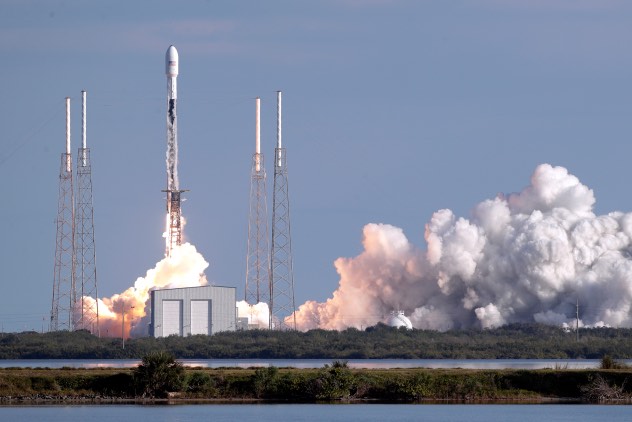SpaceX’s next astronaut mission for NASA has been delayed due to a combination of weather conditions and a technical issue, according to NASA.
The mission, known as Crew-1, was slated to lift off from Cape Canaveral, Florida, on Saturday evening. But in a blog on Friday, NASA announced that “onshore winds and first-stage booster recovery readiness” would prevent the four-person crew from taking off as planned.
Instead, Crew-1 is now scheduled to launch on Sunday at 7:27 p.m. ET.
When it does launch, the mission will mark the start of SpaceX’s first full-length, contracted astronaut mission for NASA. The crewed mission the company completed in August was considered a demonstration.
Friday’s weather delay followed a midweek assessment by the Space Force’s 45th Weather Squadron, which predicted a 40% likelihood that poor weather would force the launch to be delayed. The primary concern at that time, according to the squadron, was cumulus cloud cover associated with Tropical Storm Eta.
Current forecasts for Sunday don’t look much better: The Space Force’s latest forecast also gives the launch a 40% chance of weather delaying the launch.
SpaceX typically recovers its multi-million-dollar, 16-story rocket boosters after the hardware helps propels an upper stage toward orbit. After separating, the booster disconnects and rockets to a landing on a ship at sea. Booster recovery isn’t an essential part of launching astronauts, but it appears the equipment, staff, or both to enable that process wasn’t in order for a Saturday launch.
NASA is set to provide more details on this latest delay in a press briefing Friday evening but did not immediately respond to Business Insider’s questions about the delay.
NASA astronauts (from left) Shannon Walker, Victor Glover and Mike Hopkins, and Japan Aerospace Exploration Agency astronaut Soichi Noguchi, (right) speak to the media ahead of SpaceX’s Crew-1 mission in Cape Canaveral, Florida, November 8, 2020. NASA
This is the fourth time NASA has pushed back the launch of Crew-1 — it was originally scheduled for as early as late September. First, officials pushed back the initial launch date to October 23 to better coordinate with the schedules of other cosmonauts and astronauts going to and from the ISS. Then they delayed the launch to Halloween for the same reasons.
After that, SpaceX and NASA delayed the mission to Saturday, November 14 because of a problem found in one of SpaceX’s Falcon 9 rocket engines during a test launch. Nearly a month of investigation led SpaceX to the culprit: A red, nail-polish-like residue had clogged a valve that helps regulate the release of fuel and ignition fluid. The substance is used to cover sensitive parts of the rocket while maintenance teams are working on other parts.
Meet the Crew-1 crew
The Crew-1 crew includes NASA astronauts Shannon Walker, Mike Hopkins, and Victor Glover, as well as Japan Aerospace Exploration Agency astronaut Soichi Noguchi. Hopkins is slated to be the mission’s commander, Glover the pilot, and Walker and Noguchi mission specialists.
The Crew-1 astronauts participate in equipment testing at SpaceX headquarters in Hawthorne, California, on September 24, 2020. SpaceX
After launch, the crew will spend nearly 27 hours traveling to the International Space Station before docking at about 11 p.m. ET on Monday. Then crew members will kick off a six-month stay on the ISS, during which they’ll do science experiments and space-station maintenance.
SpaceX’s prior crewed mission, called Demo-2, proved it could safely ferry astronauts to and from the space station. That paved the way for the company to plan at least six more ISS missions as part of NASA’s Commercial Crew Program.
Demo-2 kicked off “a new era in spaceflight,” as SpaceX founder Elon Musk put it, since NASA hadn’t been able to launch its own astronauts since 2011, when it ended the space-shuttle program. Until SpaceX’s Crew Dragon became an option, NASA had been buying seats for its astronauts on Russian Soyuz spacecraft.
The Commercial Crew Program began as a series of competitions to spur private companies to develop astronaut-ready spacecraft. In 2014, NASA selected Boeing and SpaceX as the winners. NASA has estimated a spot on the Crew Dragon will cost only $55 million (not counting the funding NASA put into the ship’s development), while Russia has charged the agency up to $90 million per Soyuz seat.
Boeing’s new spaceship, the CST-100 Starliner, is slated to do an uncrewed demo mission in December. It will be the company’s second attempt, since the first uncrewed test mission of the Starliner capsule hit technical difficulties, and the ship was unable to dock with the space station as planned.





























